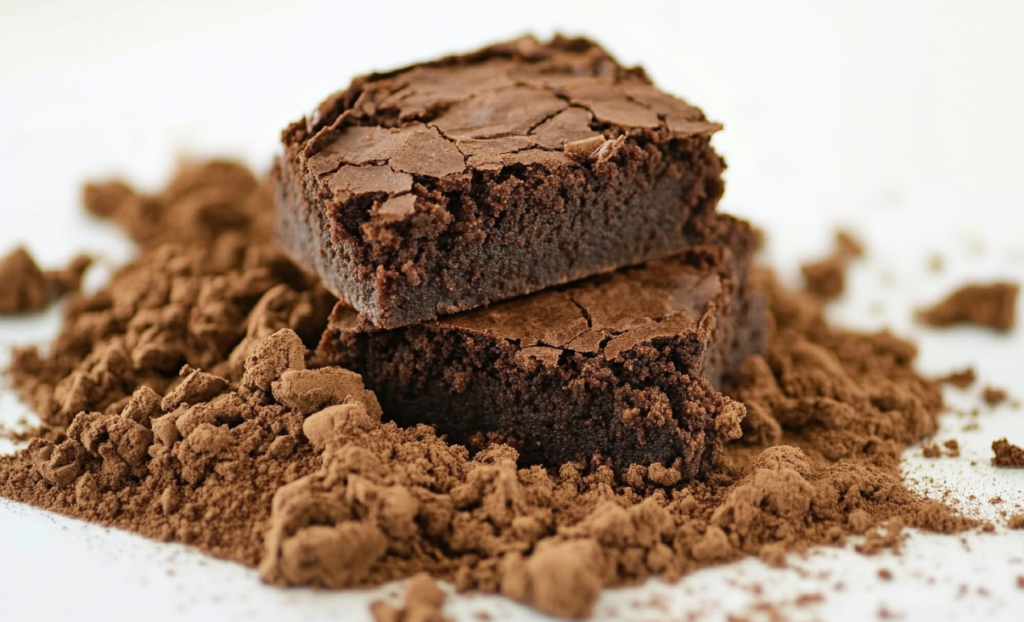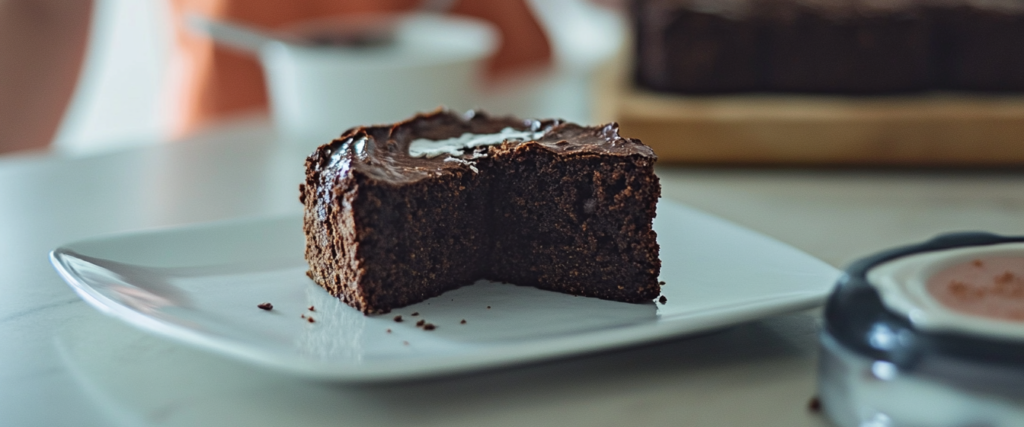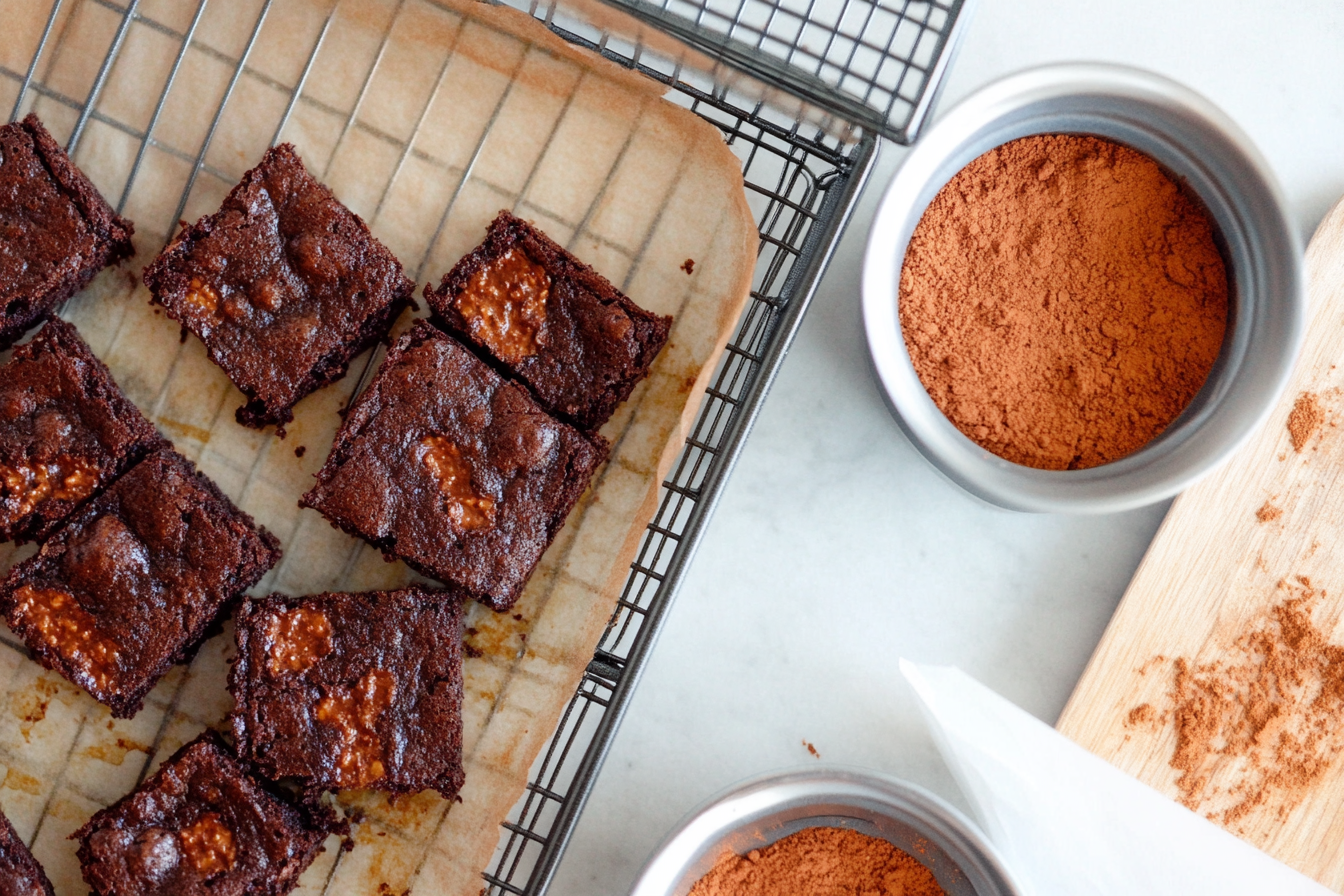What Does Sugar Do in Brownies?
Understanding the role of sugar in brownies is essential for anyone looking to modify their favorite dessert without sacrificing taste and texture. Sugar does more than just add sweetness—it plays a crucial role in creating the moist, fudgy texture and the signature crusty top layer that brownie lovers adore. When sugar dissolves during the mixing process, it helps achieve the perfect consistency, ensuring that brownies remain soft and rich rather than dry, crumbly, or overly dense.
Sweetness, Texture, and Moisture: Sugar’s Role Explained
- Sweetness: Sugar defines the flavor profile of brownies, balancing the bitterness of cocoa and enhancing its richness.
- Texture: The crystalline nature of sugar contributes to the chewy, gooey consistency.
- Moisture: Sugar retains water, preventing brownies from drying out and ensuring they stay moist longer.
This multifunctional ingredient is a cornerstone in traditional brownie recipes, but what happens when you decide to replace sugar?
Common Types of Sugar Used in Brownies
- White Granulated Sugar: The most common choice, offering a clean, neutral sweetness.
- Brown Sugar: Adds depth and a slight molasses flavor, enhancing richness.
- Coconut Sugar: A natural, minimally processed option with a caramel-like taste.
- Powdered Sugar: Occasionally used for a smoother, melt-in-your-mouth texture.

Health Considerations for Sugar Substitutes
Why Consider Replacing Sugar?
Many people are exploring sugar-free baking due to health concerns. Refined sugars are linked to spikes in blood glucose levels, contributing to conditions like diabetes, obesity, and heart disease. By switching to alternatives, you can enjoy brownies with a reduced calorie count and lower glycemic index.
Nutritional Impact of Sugar Substitutes
Sugar substitutes vary in their caloric content, glycemic impact, and nutritional benefits. For instance:
- Natural sweeteners like honey or maple syrup contain antioxidants and minerals.
- Artificial sweeteners often have zero calories but lack additional nutrients.
- Fruits like bananas or dates add fiber and vitamins.
Replacing sugar is more than a health choice—it’s an opportunity to introduce new flavors and nutrients into your recipes.
Allergies and Sensitivities to Sugar Alternatives
While sugar substitutes offer benefits, some individuals may experience allergies or sensitivities. For example:
- Stevia can cause bloating in some people.
- Sugar alcohols like erythritol might lead to digestive discomfort.
- Honey could trigger reactions in those with pollen allergies.
Understanding the potential risks ensures a safer baking experience.
Natural Sweeteners as Substitutes
Honey: A Natural Choice
Honey is a fantastic option for sugar replacement in brownies, offering:
- A rich, floral sweetness that complements chocolate.
- Moisture retention, which keeps brownies fudgy.
- A slightly golden hue to the finished product.
When substituting, use less honey than the amount of sugar required due to its liquid nature and stronger sweetness.
Maple Syrup for Richness
Maple syrup brings a distinct earthy flavor and works particularly well in recipes aiming for a unique twist. It:
- Adds a caramel undertone.
- Pairs beautifully with dark chocolate.
- Requires adjustments to liquid ratios in your recipe.
Agave Nectar and Its Characteristics
Known for its neutral taste and high sweetness, agave nectar is an easy substitute. It’s:
- Ideal for those seeking a mild flavor.
- Lower on the glycemic index compared to traditional sugar.
- Suitable for vegan-friendly recipes.
Using Fruits as Sweeteners
Mashed Bananas for Sweetness and Moisture
Bananas are a versatile ingredient in sugar-free brownies. They:
- Provide natural sweetness and binding properties.
- Replace both sugar and some fat in recipes.
- Add a subtle banana flavor that complements cocoa.
Use ripe bananas for maximum sweetness and an ultra-soft texture.
Applesauce: A Versatile Alternative
Applesauce is another fruit-based substitute, offering:
- Moisture and mild sweetness.
- A neutral flavor that doesn’t overpower.
- Reduced fat content when replacing oil or butter alongside sugar.
It’s perfect for lighter, fluffier brownies.
Dates and Date Syrup for Natural Sugars
Dates are packed with natural sugars, fiber, and nutrients. Use them as:
- Date puree: Blend pitted dates with water for a thick, syrupy consistency.
- Date syrup: A pre-made liquid sweetener rich in flavor and color.
These options create dense, chewy brownies with an extra layer of caramel richness.
Artificial Sweeteners in Baking
Stevia: Low-Calorie Sweetness
Stevia is a zero-calorie plant-based sweetener popular for its intense sweetness. It’s:
- Up to 300 times sweeter than sugar.
- A great option for low-calorie brownies.
- Best when used in combination with other ingredients to reduce aftertaste.
Erythritol and Xylitol: Sugar Alcohols for Baking
These sugar alcohols are:
- Popular in low-carb and keto recipes.
- Close to sugar in sweetness and texture.
- Useful for retaining the granulated crunch in brownies.
However, they can cause cooling sensations in taste and should be used cautiously.
Splenda: A Familiar Sugar Substitute
Splenda is one of the most recognizable artificial sweeteners. It:
- Offers consistent sweetness without calories.
- Works well for brownies but can affect browning during baking.

Sugar-Free Brownie Mixes and Pre-Made Options
Reviewing Popular Brands
Several brands cater to sugar-free baking enthusiasts:
- Lakanto: Uses monk fruit and erythritol for sweetness.
- Simple Mills: Focuses on clean, natural ingredients.
- Keto and Co: Specializes in low-carb, sugar-free mixes.
These options save time and allow customization.
How to Customize Premade Mixes
Enhance store-bought sugar-free mixes by:
- Adding natural sweeteners for extra flavor.
- Mixing in nuts, dark chocolate chips, or spices.
- Experimenting with dairy-free or gluten-free alternatives.
Evaluating the Nutritional Labels
When choosing a premade mix, check for:
- Sugar alcohol content: Avoid excessive amounts to prevent digestive discomfort.
- Calorie count and carb levels: Ensure they align with your dietary goals.
Part 2: Impact of Sugar Substitutes on Brownie Texture
How Moisture Levels are Affected
When replacing sugar in brownies, the moisture level is one of the most noticeable changes. Sugar not only sweetens but also absorbs water, helping to create a moist and tender crumb. Substituting sugar with alternatives requires adjustments to avoid dry or overly dense brownies.
- Liquid sweeteners like honey or maple syrup add extra moisture, often resulting in softer brownies. However, too much can make the batter overly runny.
- Fruits such as applesauce or bananas introduce moisture and binding properties, but they can also lead to a slightly denser texture.
- Artificial sweeteners and sugar alcohols, on the other hand, don’t provide moisture and may require the addition of extra liquid ingredients.
Tip: To maintain the ideal texture, consider reducing dry ingredients or adding a splash of milk or cream.
Adjusting for Sweetness Intensity
Sugar substitutes often differ in sweetness levels, meaning adjustments are essential to achieve balance:
- Stevia is intensely sweet, so a tiny amount goes a long way.
- Sugar alcohols like erythritol are less sweet than sugar, requiring slightly larger quantities.
- Natural sweeteners like honey or maple syrup match sugar’s sweetness closely but carry their own distinct flavors.
Experimenting with ratios and combinations can help you fine-tune the sweetness while maintaining harmony with the cocoa and other flavors.
Testing for Crumbliness and Binding Issues
Sugar contributes to the structural integrity of brownies by caramelizing during baking. Without it, your brownies might crumble. To counter this:
- Incorporate binding agents such as eggs, flaxseed meal, or chia seeds.
- Use pureed fruits like bananas or dates, which naturally bind and moisten the batter.
- Add a small amount of gluten or xanthan gum to mimic sugar’s binding effect in gluten-free recipes.
Balancing Flavors Without Sugar
Enhancing Cocoa’s Richness
In sugar-free brownies, the cocoa flavor takes center stage. Boost its richness by:
- Using high-quality cocoa powder or unsweetened dark chocolate.
- Incorporating a pinch of salt to amplify the natural sweetness.
- Opting for Dutch-processed cocoa for a smoother, less acidic taste.
Adding Vanilla and Spices for Complexity
Vanilla and spices are invaluable in sugar-free baking, offering layers of flavor that compensate for the lack of sugar:
- Vanilla extract: Adds depth and a sense of sweetness.
- Cinnamon or nutmeg: Introduce warmth and enhance the chocolate profile.
- Cardamom or chili powder: For adventurous bakers, these spices create a unique flavor twist.
Incorporating Coffee or Espresso for Depth
Coffee is a secret weapon in chocolate-based recipes. Even a small amount of brewed coffee or espresso powder can:
- Deepen the chocolate flavor.
- Create a more robust taste profile.
- Add a subtle bitterness that balances sweetness.
Low-Carb and Keto-Friendly Alternatives
Almond Flour and Coconut Flour Combinations
When crafting keto-friendly brownies, traditional flour is often replaced with low-carb options like almond and coconut flour. These flours:
- Provide a nutty flavor that complements chocolate.
- Require less quantity due to their density.
- Demand careful balancing of liquid ratios to prevent dryness.
Monk Fruit Sweetener for Keto Baking
Monk fruit sweetener, often blended with erythritol, is an excellent choice for keto recipes. It:
- Is zero-calorie and low-carb.
- Has a clean, sugar-like sweetness.
- Pairs well with almond or coconut flour.
Adjusting Liquid Ratios for Keto Brownies
Low-carb flours absorb more liquid than traditional flour, so you’ll need to:
- Increase wet ingredients like eggs, butter, or cream.
- Monitor the consistency of the batter to prevent over-thickening.
Common Mistakes When Replacing Sugar
Overpowering Sweeteners
Some sugar substitutes, like stevia or artificial sweeteners, have strong aftertastes when used in excess. To avoid this:
- Use sweeteners sparingly or in combination with milder alternatives.
- Blend natural sweeteners like honey with sugar alcohols for a balanced flavor.
Misjudging Liquid Ratios
Substituting sugar with liquid sweeteners can upset the delicate balance of wet and dry ingredients. Key tips include:
- Reducing other liquids like milk or water.
- Adding a stabilizer, such as cornstarch, to thicken the batter.
Texture Issues in the Final Product
Brownies made with sugar substitutes may:
- Lack the signature chewiness of traditional recipes.
- Be prone to dryness or crumbliness without proper adjustments.
- Require extra care during mixing to avoid overworking the batter.
Balancing Flavors Without Sugar
Enhancing Cocoa’s Richness
With no sugar to mask it, the cocoa in your brownies takes center stage. You can elevate it by:
- Choosing premium cocoa powder for intense chocolate flavor.
- Adding a pinch of salt to counteract bitterness and enhance sweetness.
- Using unsweetened chocolate chips for added texture.
Adding Vanilla and Spices for Complexity
Spices and extracts can enhance the flavor profile of sugar-free brownies:
- Vanilla extract gives a sweet aroma and depth of flavor.
- Cinnamon or nutmeg adds warmth.
- Cardamom or chili powder introduces unique, bold notes.
Incorporating Coffee or Espresso for Depth
Coffee is a natural flavor enhancer for chocolate. Adding:
- Brewed espresso or coffee for a richer flavor.
- A sprinkle of espresso powder directly into the batter.
Part 3: Step-by-Step Guide to Sugar-Free Brownies
Tools and Ingredients Needed
Making sugar-free brownies requires a few specialized tools and ingredients to get the perfect consistency and flavor. Here’s what you’ll need:
Essential Tools:
- Mixing bowls for wet and dry ingredients
- A whisk, spatula, and hand mixer
- Measuring cups and spoons
- An 8×8-inch baking pan lined with parchment paper
- Optional: Food processor (if using dates or purees)
Ingredients:
- Cocoa powder or unsweetened chocolate
- Your chosen sugar substitute (e.g., stevia, monk fruit, or erythritol)
- Binding agents like eggs or flaxseed meal for vegan options
- Fats such as butter, coconut oil, or avocado
- Optional flavor enhancers like vanilla extract, coffee powder, or cinnamon
Preparation Tips:
- Preheat your oven to 350°F (175°C).
- Measure ingredients accurately to maintain the right texture and sweetness.
- Grease the baking pan or line it with parchment paper for easy removal.
Adjusting Recipes for Sweeteners
Sugar substitutes differ in sweetness, texture, and baking properties. Here’s how to adapt your recipes:
- Sweetness Levels: Adjust quantities according to the sweetener’s intensity. For instance, stevia is much sweeter than sugar, so use only a small amount.
- Balancing Liquids: Liquid sweeteners like honey or maple syrup may require reducing other liquids, while sugar alcohols might need added moisture.
- Enhancing Flavors: Add a pinch of salt, extra vanilla extract, or espresso powder to mask any aftertaste from artificial sweeteners.
These tweaks ensure a balance between sweetness and the chocolatey richness of your brownies.
Baking and Cooling Tips for Perfect Results
Baking sugar-free brownies can be tricky since sugar contributes to caramelization and structure. Follow these steps for optimal results:
- Mix with Care: Combine wet and dry ingredients gently to avoid overmixing, which can lead to dense or tough brownies.
- Monitor Baking Time: Sugar-free brownies often bake faster. Start checking for doneness 5 minutes earlier than the recipe suggests.
- Cool Completely: Let brownies cool fully in the pan before slicing. This helps set the texture and ensures clean cuts.
Sugar-Free Brownie Recipes
Classic Sugar-Free Brownies
Ingredients:
- 1/2 cup almond flour
- 1/3 cup unsweetened cocoa powder
- 1/2 cup erythritol or monk fruit sweetener
- 2 large eggs (or flaxseed substitute)
- 1/3 cup melted butter or coconut oil
- 1 tsp vanilla extract
- Pinch of salt
Instructions:
- Preheat oven to 350°F (175°C). Grease or line an 8×8-inch pan.
- Whisk the eggs, melted butter, and vanilla in a bowl.
- In another bowl, mix the almond flour, cocoa powder, erythritol, and salt.
- Combine the wet and dry ingredients until smooth.
- Pour into the pan and bake for 20–25 minutes.
- Cool before slicing.
Vegan and Gluten-Free Brownies
Ingredients:
- 1 cup mashed bananas or applesauce
- 1/3 cup cocoa powder
- 1/2 cup almond butter
- 1/3 cup coconut flour
- 1/4 cup maple syrup
- 1 tsp vanilla extract
Instructions:
- Preheat oven to 350°F (175°C).
- Combine mashed bananas, almond butter, and maple syrup.
- Add cocoa powder, coconut flour, and vanilla. Mix well.
- Bake for 20–22 minutes. Let cool before serving.
Tips for Storing and Preserving Sugar-Free Brownies
To maintain freshness and flavor:
- Short-Term Storage: Store in an airtight container at room temperature for up to 3 days or refrigerate for up to a week.
- Freezing for Long-Term Use: Wrap individual portions in plastic wrap and place them in a freezer-safe bag. Brownies can last up to 3 months in the freezer.
- Reheating Tips: Microwave frozen brownies for 15–20 seconds for a fresh-out-of-the-oven taste.
Health Benefits of Sugar-Free Brownies
- Lower Calories: Reducing or eliminating sugar can significantly cut the calorie count.
- Blood Sugar Stability: Ideal for diabetics or those managing blood sugar levels, as sugar-free brownies often have a lower glycemic index.
- Nutrient Boost: Using alternatives like fruits or natural sweeteners adds vitamins, minerals, and fiber.
Sugar-free baking supports health-conscious choices while still delivering delicious results.
Frequently Asked Questions (FAQs)
- Can I completely omit sweeteners?
Yes, but the brownies will rely solely on the natural sweetness of cocoa or fruits. - What’s the best sugar substitute for baking?
Monk fruit or erythritol works well as they mimic sugar’s texture. - Are natural sweeteners healthier than artificial ones?
Natural sweeteners like honey or dates provide added nutrients, but they still contain sugars. - Can sugar-free brownies taste as good as regular ones?
With the right balance of flavors and substitutes, sugar-free brownies can be just as satisfying. - Do sugar-free brownies bake differently?
Yes, they may require shorter baking times and adjustments to liquids. - Can I use coconut sugar?
Coconut sugar isn’t sugar-free but is lower on the glycemic index than regular sugar. - How can I make brownies more moist without sugar?
Add pureed fruits or increase the fat content with butter or avocado. - What’s a good vegan sweetener option?
Maple syrup or agave nectar works well in vegan recipes. - How long do sugar-free brownies last?
Refrigerated brownies last up to a week, while frozen ones stay good for three months. - Can I use stevia for all my baking?
Yes, but its strong sweetness may need careful balancing with other flavors.
Related Article : Why does the US military have a 26 page brownie recipe?

